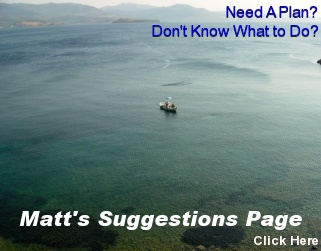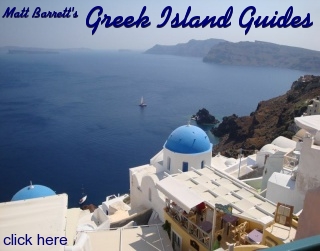Karpenissi, Trikala, Meteora
|
|
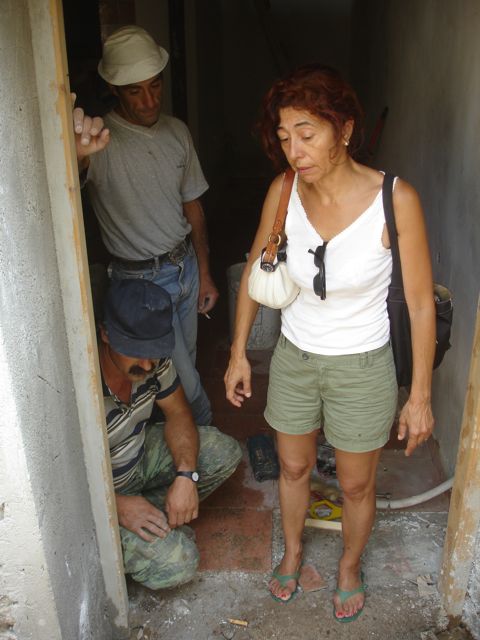 I was happily drinking my coffee laying in the bed next to Andrea when the rock and roll ring of my cell phone cut through the Mozart that was playing from my Ipod speakers. It was Andrea's sister Pam. "Get dressed. I am coming down the street with the tile man and we will be at the gate in 2 minutes". So much for my relaxing morning
in our new house. Its not really a new house. Andrea's grandmother came back to her ancestral village and bought it sometime in the
sixties because all the family property had been divided up between the relatives who had remained in Greece, or sold. She probably paid about $5000 for it, if that. It was a tiny house with 2 upstairs bedrooms big enough for a double bed and a trunk and not much else. There was a small kitchen and a front room which was a little bigger, and a courtyard about as big as a normal sized American bedroom. I don't know how long she lived in the house but it was empty when we came in the mid-nineties. We swept out
the dust and stayed here for a couple weeks and Pam replaced the roof, windows and shutters. After we left, Andrea's Uncle Mitzos rented it to some Albanian workers who burned every piece of furniture in the fireplace to keep warm one winter. They destroyed the house and when Mitzo kicked them out it got worse as animals got in and people threw their garbage in the ruin. Someone offered 5000 euros for it and Pam was tempted to take it. I was the one who said to fix it. We already had one embarrassing ruin
of a house in Kyparissi that we could not fix because of the greed and stubbornness of my relatives. Lets turn this failure into a success I said one day in America. Pam is an architect, speaks fluent Greek and spent 10 years restoring her own house in Vatousa so she became the contractor and I paid for it. When I came back to Lesvos and saw the condition of the house I almost changed my mind. I could not imagine that you could do anything but let it fall down like the house next door which is now the chicken
coop of the woman across the street, the person who wanted to buy ours to give her chickens more room. Work began last summer and even then it was hard to imagine it being livable. One year later and we are living in it and it though small it is one of the most beautiful and efficiently designed houses in the village. Clay colored tile floors, white walls and cream colored ceilings and exposed beams, if this was a NYC apartment it would be worth about $750,000. I was happily drinking my coffee laying in the bed next to Andrea when the rock and roll ring of my cell phone cut through the Mozart that was playing from my Ipod speakers. It was Andrea's sister Pam. "Get dressed. I am coming down the street with the tile man and we will be at the gate in 2 minutes". So much for my relaxing morning
in our new house. Its not really a new house. Andrea's grandmother came back to her ancestral village and bought it sometime in the
sixties because all the family property had been divided up between the relatives who had remained in Greece, or sold. She probably paid about $5000 for it, if that. It was a tiny house with 2 upstairs bedrooms big enough for a double bed and a trunk and not much else. There was a small kitchen and a front room which was a little bigger, and a courtyard about as big as a normal sized American bedroom. I don't know how long she lived in the house but it was empty when we came in the mid-nineties. We swept out
the dust and stayed here for a couple weeks and Pam replaced the roof, windows and shutters. After we left, Andrea's Uncle Mitzos rented it to some Albanian workers who burned every piece of furniture in the fireplace to keep warm one winter. They destroyed the house and when Mitzo kicked them out it got worse as animals got in and people threw their garbage in the ruin. Someone offered 5000 euros for it and Pam was tempted to take it. I was the one who said to fix it. We already had one embarrassing ruin
of a house in Kyparissi that we could not fix because of the greed and stubbornness of my relatives. Lets turn this failure into a success I said one day in America. Pam is an architect, speaks fluent Greek and spent 10 years restoring her own house in Vatousa so she became the contractor and I paid for it. When I came back to Lesvos and saw the condition of the house I almost changed my mind. I could not imagine that you could do anything but let it fall down like the house next door which is now the chicken
coop of the woman across the street, the person who wanted to buy ours to give her chickens more room. Work began last summer and even then it was hard to imagine it being livable. One year later and we are living in it and it though small it is one of the most beautiful and efficiently designed houses in the village. Clay colored tile floors, white walls and cream colored ceilings and exposed beams, if this was a NYC apartment it would be worth about $750,000.
|
|
Its still a work in progress though and the tile guy is here with his little 5 year old daughter watching him putting in ceramic towel hangers and other bathroom devices. Andrea and Pam are upstairs assembling the bookshelf. Andrea just chased a chicken off the wall who smelled Pam's bag of croissants. We are expecting the upstairs bed and the painter later today. There is all sorts of activity going on around me as I type this.
|
|
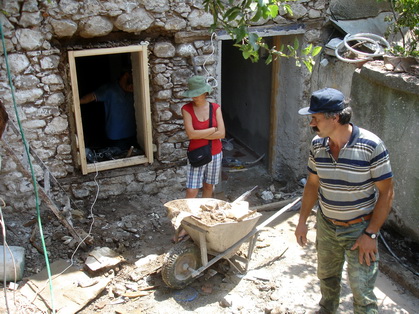
Xidera House Before
|
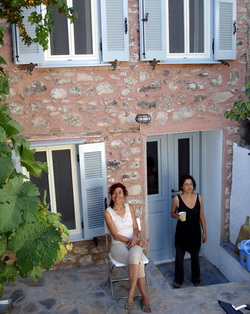
Xidera House After
|
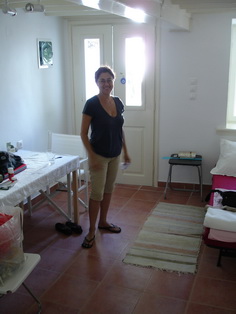
|
|
|
|
Xidera is the most remote village in Lesvos but it has a state-of-the-art winery, Methymnaos, a new smelly cheese factory, and a brand new high tech Iakovides Art Museum that when it opens in September will be the talk of the island if not of Greece. (For more on Xidera check out www.lesvos.com)
There is no Internet here, not even for my Cosmote Internet on the Go but that's good because since I can't get e-mail I can update you on my trip here which if you recall began with us planning to go to the 4th of July Celebration in Lagonissi one week ago from today.
|
|
July 4th. The Road to Karpenissi
 When we got off the ferry in Lavrion and it was 100 degrees we pretty much gave up the idea of going to the 4th of July thing. Maybe it was the idea of picking up garbage on the beach for half an hour, playing touch football and eating hotdogs during a heatwave. So we drove to Venizelos Airport, put Andrea's mother on a jet to Lesvos and got
on the National
Road out of Athens. We went through the city of Thebes, a sprawling mess of apartment buildings with an outer industrial
area like just about every major town we went through. We took the old road to Lamia instead of the National road and passed the giant lion statue of Chaironia that commemorated the final battle between Phillip of Macedon and the Thebians in 338 BC. It was this battle that established Philip as undisputed ruler of southern Greece and his son Alexander also commanded forces in the fight. The base of the statue alone is 7 meters high
and was built where the Theban Sacred Band was buried. We took a photo of me next to it that gives an idea of the size but Andrea accidentally deleted every photo in her camera at lunch with her family one day in Gavatha, Lesvos because she was so stressed out from the trip and the reunion with her sister, daughter and mother, all of whom stress her out even more than I do. When we got off the ferry in Lavrion and it was 100 degrees we pretty much gave up the idea of going to the 4th of July thing. Maybe it was the idea of picking up garbage on the beach for half an hour, playing touch football and eating hotdogs during a heatwave. So we drove to Venizelos Airport, put Andrea's mother on a jet to Lesvos and got
on the National
Road out of Athens. We went through the city of Thebes, a sprawling mess of apartment buildings with an outer industrial
area like just about every major town we went through. We took the old road to Lamia instead of the National road and passed the giant lion statue of Chaironia that commemorated the final battle between Phillip of Macedon and the Thebians in 338 BC. It was this battle that established Philip as undisputed ruler of southern Greece and his son Alexander also commanded forces in the fight. The base of the statue alone is 7 meters high
and was built where the Theban Sacred Band was buried. We took a photo of me next to it that gives an idea of the size but Andrea accidentally deleted every photo in her camera at lunch with her family one day in Gavatha, Lesvos because she was so stressed out from the trip and the reunion with her sister, daughter and mother, all of whom stress her out even more than I do.
We were traveling on a large agricultural plain separated from the sea by a small mountain range but decided to cut across and pass Thermopylae to take enough photos to show it was not worth going to for all the people who became enamoured with it after seeing the movie '300'. The pass no longer exists because the sea has silted up say the guidebooks and besides the statue of Leonidas, the leader of the Spartans there is nothing to see. But if recent excavations
suggest that
the beloved Ithaka of Odysseus was actually the island of Kefalonia and not
the island now called Ithaki, then couldn't they be wrong about the location of Thermopylae? Its a moot point because in a tiny mountain village there was an 18 wheeler truck that was stuck on a curve, hopelessly wedged in and probably not going anywhere for the next day or so since it was blocking the only road out of town. We turned around and drove back down to the plain and continued on to Lamia. Actually we had not realized that we were on a high plain until we found ourselves driving down some mountains
to Lamia which was at sea level in a vast wetland and agricultural area. Lamia was another city of ugly apartment buildings haphazardly arranged with a center that could have been a neighborhood in Kypseli surrounded by fields, factories and unattractive buildings. We would see this a lot on our trip.
|
|
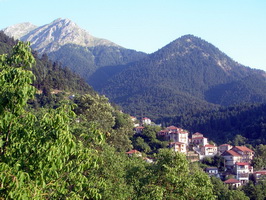 From Lamia we followed the road to Karpenissi and as the road begins to rise through the hills and into the mountains the outside temperature on my car's thermometer drops until its about 18 centigrade. There is a roadblock of cops in bullet proof vests just before the tunnel that leads to Karpenissi, probably looking for Ossama Bin Laden. We are beneath their
notice and they just ask where we are going and wave us through. From Lamia we followed the road to Karpenissi and as the road begins to rise through the hills and into the mountains the outside temperature on my car's thermometer drops until its about 18 centigrade. There is a roadblock of cops in bullet proof vests just before the tunnel that leads to Karpenissi, probably looking for Ossama Bin Laden. We are beneath their
notice and they just ask where we are going and wave us through.
Karpenissi is not an attractive city.(That's not it in the photo. I didn't take any photos of Karpenissi.) Maybe it was once but now it is like the others, ugly apartment buildings and a congested downtown only it is built on the side of a mountain instead of on a flat plain in grid fashion. This is the poorest area of Greece, or at least it was until everyone left and moved to America and got rich and came back with their money. The guidebooks say that Karpenissi
is the largest town of the region known as Evritania
with a population of 5000 people but I dispute that number. Looks more like fifteen or twenty thousand and it probably doubles in the winter when Athenians come here to ski. But we did little more than drive through it. We were going to Megalo Horio, a town half an hour down a lush wooded valley that happens to be the ancestral home of my friend John Dimos who owns the Drydock Fish Restaurant between Pittsboro and Chapel Hill, North Carolina.
|
|
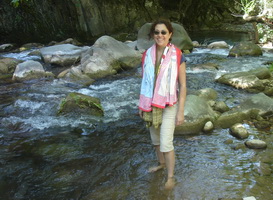 The village of Megalo Horio was in the forest on the side of a mountain. We drove through it and then asked directions for the Agrampeli apartments owned by John's cousin Fotini. We had to drive down to the bottom of the village, cross the river on a bridge just wide enough for our car (Andrea was terrified) and into the community of Gavros, a collection
of small shops, a few tavernas and some houses. We found the apartments right away, got a room overlooking
the pool and the mountain, and marveled at the temperature and the fact that it looked and felt like the mountains of North Carolina. Is that the reason that so many of North Carolina's Greeks are from the Karpenissi area? Did they wander around America until they found a place that reminded them of home? It sure looked like it. I took a swim in the pool which seemed to have no chlorine. There was a river just below the apartments so I am assuming that the water is always circulating. The village of Megalo Horio was in the forest on the side of a mountain. We drove through it and then asked directions for the Agrampeli apartments owned by John's cousin Fotini. We had to drive down to the bottom of the village, cross the river on a bridge just wide enough for our car (Andrea was terrified) and into the community of Gavros, a collection
of small shops, a few tavernas and some houses. We found the apartments right away, got a room overlooking
the pool and the mountain, and marveled at the temperature and the fact that it looked and felt like the mountains of North Carolina. Is that the reason that so many of North Carolina's Greeks are from the Karpenissi area? Did they wander around America until they found a place that reminded them of home? It sure looked like it. I took a swim in the pool which seemed to have no chlorine. There was a river just below the apartments so I am assuming that the water is always circulating.
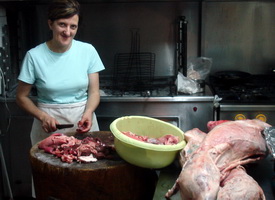 There was plenty of water in the village. Streams everywhere with waterfalls leading into the main river which was about thirty feet wide and so cold my feet were numb in about thirty seconds. Our first friend was Vassilis who with his brother and sister ran a small gift shop in Gavros selling jars full of plastic fruit
in water. They also
had real fruit preserved and a lot of different home made alcoholic drinks like tsipuro, flavored with local fruits. We had several glasses of tsipuro and then bought a bottle before walking down the street to the Spiti Tou Psara, famous for its fresh trout. Andrea had the trout and I had paidakia along with home made spanakopita, tiropita and delicious home made fried potatoes. There was only one other couple eating there on the balcony that overlooked the river. Inside Maria,our waitress was
preparing several whole lambs for a baptism that was being held in the village the following day, while the owner Efthimios and his pals were talking over drinks at a table indoors. It was the first time this summer where we considered eating indoors because outside it was actually chilly outside. Just beyond the restaurant is an old trout farm that has closed down. Anyone who has ever wanted to own a trout farm should come up here and check it out. There is not much to do in Gavros once dinner is over. The whole
main street is about fifty meters long so after dinner we went back to our room and went to sleep. There was plenty of water in the village. Streams everywhere with waterfalls leading into the main river which was about thirty feet wide and so cold my feet were numb in about thirty seconds. Our first friend was Vassilis who with his brother and sister ran a small gift shop in Gavros selling jars full of plastic fruit
in water. They also
had real fruit preserved and a lot of different home made alcoholic drinks like tsipuro, flavored with local fruits. We had several glasses of tsipuro and then bought a bottle before walking down the street to the Spiti Tou Psara, famous for its fresh trout. Andrea had the trout and I had paidakia along with home made spanakopita, tiropita and delicious home made fried potatoes. There was only one other couple eating there on the balcony that overlooked the river. Inside Maria,our waitress was
preparing several whole lambs for a baptism that was being held in the village the following day, while the owner Efthimios and his pals were talking over drinks at a table indoors. It was the first time this summer where we considered eating indoors because outside it was actually chilly outside. Just beyond the restaurant is an old trout farm that has closed down. Anyone who has ever wanted to own a trout farm should come up here and check it out. There is not much to do in Gavros once dinner is over. The whole
main street is about fifty meters long so after dinner we went back to our room and went to sleep.
July 5th. Karpenissi to Meteora
|
|
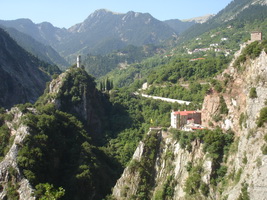 The next day we drove down the valley alongside the river to the Proussou Monastery in a spectacular location on the road to Agrinion. Rocks were scattered along the way and you can see that they are piled on the side of the road as if every so often a snowplow has to come and clear them. The chances of being hit by one is slim but you sort
of have to be on the alert anyway because though it is unlikely one would be covered in a landslide, being smacked by an individual rock was not out
of the question. Halfway to the monastery where two rivers meet is a center for white water rafting, though the rivers were not deep enough for that in the summer. Its probably a great place to go in the early spring. We drove back to Gavros where two old guys were making kokoretsi and roast lamb in one of the shops. I asked them if they were doing it for the baptism. "No, we do this every Saturday" they told me. So if you like roast lamb and kokoretsi go to Gavros on Saturday. We drove up to Micro
Horio which was across the river valley from Megalo Horio. It was a settlement of modern looking houses, some made of wood. They use a lot of wood up here. Wood is to Evritainia as rocks are to the Cyclades. We crossed the bridge and went back up to Megalo Horio and had a coffee in the shaded main square and then walked one of the paths through the woods over a small wooden bridge that crossed another stream. The people who sell bottled water must hate this area. With fresh spring water pouring out of the mountain,
the waiter in the cafe would fill our water glasses from the fountain in the square. The next day we drove down the valley alongside the river to the Proussou Monastery in a spectacular location on the road to Agrinion. Rocks were scattered along the way and you can see that they are piled on the side of the road as if every so often a snowplow has to come and clear them. The chances of being hit by one is slim but you sort
of have to be on the alert anyway because though it is unlikely one would be covered in a landslide, being smacked by an individual rock was not out
of the question. Halfway to the monastery where two rivers meet is a center for white water rafting, though the rivers were not deep enough for that in the summer. Its probably a great place to go in the early spring. We drove back to Gavros where two old guys were making kokoretsi and roast lamb in one of the shops. I asked them if they were doing it for the baptism. "No, we do this every Saturday" they told me. So if you like roast lamb and kokoretsi go to Gavros on Saturday. We drove up to Micro
Horio which was across the river valley from Megalo Horio. It was a settlement of modern looking houses, some made of wood. They use a lot of wood up here. Wood is to Evritainia as rocks are to the Cyclades. We crossed the bridge and went back up to Megalo Horio and had a coffee in the shaded main square and then walked one of the paths through the woods over a small wooden bridge that crossed another stream. The people who sell bottled water must hate this area. With fresh spring water pouring out of the mountain,
the waiter in the cafe would fill our water glasses from the fountain in the square.
We left Megalo Hori and drove north to Karpenissi and then took the mountain roads towards Karditsa. The temperature never got above 27c and I never realized how many miles of pine forests still remained in Greece. We passed a small Sarakatsani settlement where they bring their sheep in the spring and a fighter jet parked at a crossroads high in the mountains. Past a large man-made lake and a spa town
(which I forget the name of and am too lazy to go to the car and get my map) of we met up with another river and followed it down through
the mountains and on to another agricultural plain and the long straight road to Karditsa, yet another ugly agricultural town of apartment buildings.(sorry if you are from here)
|
|
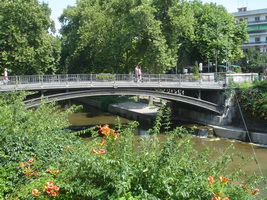 Andrea was reading the description of Trikala, the birthplace of Tsitsanis, and it sounded kind of attractive though the road leading into the town looked like all the others. But once we got into Trikala we were really pleasantly surprised. The first thing we found was an enormous old mosque next to a river that was full of trout. There were
so many they
were bumping into each other. Thousands of them. I don't know how safe they were to eat, being in the middle of an agricultural city surrounded
by farms and industry but if you wanted to fish here for the fun of it what could be more fun than catching a trout every 5 seconds, even if you are just going to feed it to your cat, (or the cat of your neighbor who you don't like). Further on we found the center of town where there were two bridges over the river and a tree shaded park. The river was lined with trees and flowers and it looked like Paris in the springtime. The city was full of young people, some on bicycles and though it was hot as hell Trikala
seemed like a place I would want to come back to and seriously explore. Above the city is a kastro with a pond and a cafe in the shade where the waiter brought us water even though we were not going to stay, just because we looked thirsty. Below the kastro was the old Turkish settlement of small winding streets and historical houses. Andrea was reading the description of Trikala, the birthplace of Tsitsanis, and it sounded kind of attractive though the road leading into the town looked like all the others. But once we got into Trikala we were really pleasantly surprised. The first thing we found was an enormous old mosque next to a river that was full of trout. There were
so many they
were bumping into each other. Thousands of them. I don't know how safe they were to eat, being in the middle of an agricultural city surrounded
by farms and industry but if you wanted to fish here for the fun of it what could be more fun than catching a trout every 5 seconds, even if you are just going to feed it to your cat, (or the cat of your neighbor who you don't like). Further on we found the center of town where there were two bridges over the river and a tree shaded park. The river was lined with trees and flowers and it looked like Paris in the springtime. The city was full of young people, some on bicycles and though it was hot as hell Trikala
seemed like a place I would want to come back to and seriously explore. Above the city is a kastro with a pond and a cafe in the shade where the waiter brought us water even though we were not going to stay, just because we looked thirsty. Below the kastro was the old Turkish settlement of small winding streets and historical houses.
|
|
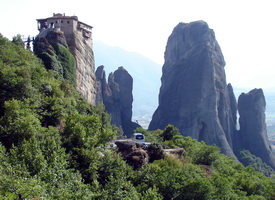 From Trikala its just another 25 kilometers down a long straight road to Kalambaka and Meteora, in fact you can see the giant rocks as soon as you leave the town. As you get closer it gets more touristy and on the edge of town the factories, warehouses and farms give way to hotels and signs advertising hotels. Kalambaka is totally built up,
it's a small
city, not the little town it used to be, with a main street and traffic lights and shops, restaurants and cafes and a fountain in every square. It sits below the giant rocks that make up the backside of Meteora. You can drive up one of the streets that lead uphill, park the car and go walking off into the hills on a path among the olive groves. If you go through the city you come to Kastrika which is a smaller town below the monasteries on the giant rocks of Meteora. Lots of hotels and tavernas with their menus
in English and German. We drove through town and up to the monasteries. It was late in the day but over 100 degrees. Every time we found a spot to pull off I took a photo though often the sun was in the exact wrong spot. That's OK though because the photos my father took in 1963 were better than anything I could take.(See www.greecetravel.com/photos/sixties and they are in the mainland section). There were lots of tourists looking totally American but speaking
completely foreign eastern European languages,
victims of the global economy and giant tour buses driving up and down the small mountain roads. It kind of made me want to take my photos and get out of town and we talked about leaving and heading up to the mountains towards Kastoria where it was cooler but I had been driving all day. I really didn't like Kalambaka though. OK, its a place you have to go if you visit Greece, because the monasteries of Meteora are essential, but I can't see spending more than a night here. Its too busy, too commercial and too
ugly, like those agricultural-industrial provincial towns like Lamia and Karditsa only the industry here is tourists. From Trikala its just another 25 kilometers down a long straight road to Kalambaka and Meteora, in fact you can see the giant rocks as soon as you leave the town. As you get closer it gets more touristy and on the edge of town the factories, warehouses and farms give way to hotels and signs advertising hotels. Kalambaka is totally built up,
it's a small
city, not the little town it used to be, with a main street and traffic lights and shops, restaurants and cafes and a fountain in every square. It sits below the giant rocks that make up the backside of Meteora. You can drive up one of the streets that lead uphill, park the car and go walking off into the hills on a path among the olive groves. If you go through the city you come to Kastrika which is a smaller town below the monasteries on the giant rocks of Meteora. Lots of hotels and tavernas with their menus
in English and German. We drove through town and up to the monasteries. It was late in the day but over 100 degrees. Every time we found a spot to pull off I took a photo though often the sun was in the exact wrong spot. That's OK though because the photos my father took in 1963 were better than anything I could take.(See www.greecetravel.com/photos/sixties and they are in the mainland section). There were lots of tourists looking totally American but speaking
completely foreign eastern European languages,
victims of the global economy and giant tour buses driving up and down the small mountain roads. It kind of made me want to take my photos and get out of town and we talked about leaving and heading up to the mountains towards Kastoria where it was cooler but I had been driving all day. I really didn't like Kalambaka though. OK, its a place you have to go if you visit Greece, because the monasteries of Meteora are essential, but I can't see spending more than a night here. Its too busy, too commercial and too
ugly, like those agricultural-industrial provincial towns like Lamia and Karditsa only the industry here is tourists.
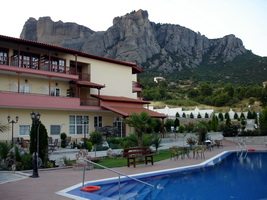 I called Billy, the son of George the Famous Taxi driver and asked where he thought we should stay. He gave me a couple choices and we went to the big American style place called the Famissi Eden with a swimming pool on the edge of town because I thought that had the best chance of having a good air-conditioner. It didn't.
Eventually the room cooled down enough to survive the night. The hotel was full of American high school students and had a large cafe area full of Greeks who were there for some kind of performance because all the children were dressed up in costumes from the last century. We never knew what it was about because they all climbed on a big bus and drove away and we never saw them again. The pool was nice and I swam around for about an hour looking at the giant rock above the hotel. One of the best things about the
hotel was the copies of famous Greek
paintings that lined the hall, maybe not enough to forgive a room with bad air-conditioning, though hopefully enough people will complain about their antiquated system so that they replace it. I called Billy, the son of George the Famous Taxi driver and asked where he thought we should stay. He gave me a couple choices and we went to the big American style place called the Famissi Eden with a swimming pool on the edge of town because I thought that had the best chance of having a good air-conditioner. It didn't.
Eventually the room cooled down enough to survive the night. The hotel was full of American high school students and had a large cafe area full of Greeks who were there for some kind of performance because all the children were dressed up in costumes from the last century. We never knew what it was about because they all climbed on a big bus and drove away and we never saw them again. The pool was nice and I swam around for about an hour looking at the giant rock above the hotel. One of the best things about the
hotel was the copies of famous Greek
paintings that lined the hall, maybe not enough to forgive a room with bad air-conditioning, though hopefully enough people will complain about their antiquated system so that they replace it.
|
|
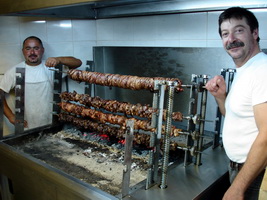 I asked Billy where we should have dinner. "Go to Pellenion, in the third square. Its the only good place. If you eat anywhere else you will get sick." This seemed extreme to me. For every restaurant in the town to make you sick except one would have to be some kind of conspiracy.
Its not possible, even in Greece.
We drove to the restaurant and Andrea vetoed it right away. Big signs in English advertising mousaka and pastistio and fried squid, and tables in the hot square where it was still about 90 degrees with a handful of tourists drinking draft beer was not what either of us had in mind. Maybe it was the best in Kalambaka but if so we would not eat in Kalambaka. Instead we followed the advice of Rough Guide and drove out of town to the small village of Diaba, down a small road through farms and trees to the Neromylos
(watermill) Fish Taverna. The restaurant was built in an old watermill
and they had made cement ponds in the mill itself where there were trout. It was also a psistaria with kokoretsi, lamb and pork kontosouvli (on the spit) and lots of other grilled meats, all from their farm. It was the most perfect taverna in the world. They were playing my favorite palio rembetika songs and they gave us a table next to the bridge over the small pond where several frogs courted each other with voices louder than the music. The food was exceptional. In the north they serve a politiki salata which
is like a spicy cold slaw. We had that and cheese crokettes, fried zucchini and sadziki, Andrea had a delicious grilled trout and I had what I had been craving the whole trip, roast lamb and kokoretsi. In case you don't know, kokoretsi is the intestines of a lamb, stuffed with liver and spleen and whatever is edible inside a lamb. We drank the red wine and the white, both delicious and even drank some local tsipuro. As we ate the taverna filled with more and more people, mostly local so we kept eating a drinking
just to continue the party and by the time we left we were so stuffed
we could barely walk. I was sick all night. (Billy was right!) I asked Billy where we should have dinner. "Go to Pellenion, in the third square. Its the only good place. If you eat anywhere else you will get sick." This seemed extreme to me. For every restaurant in the town to make you sick except one would have to be some kind of conspiracy.
Its not possible, even in Greece.
We drove to the restaurant and Andrea vetoed it right away. Big signs in English advertising mousaka and pastistio and fried squid, and tables in the hot square where it was still about 90 degrees with a handful of tourists drinking draft beer was not what either of us had in mind. Maybe it was the best in Kalambaka but if so we would not eat in Kalambaka. Instead we followed the advice of Rough Guide and drove out of town to the small village of Diaba, down a small road through farms and trees to the Neromylos
(watermill) Fish Taverna. The restaurant was built in an old watermill
and they had made cement ponds in the mill itself where there were trout. It was also a psistaria with kokoretsi, lamb and pork kontosouvli (on the spit) and lots of other grilled meats, all from their farm. It was the most perfect taverna in the world. They were playing my favorite palio rembetika songs and they gave us a table next to the bridge over the small pond where several frogs courted each other with voices louder than the music. The food was exceptional. In the north they serve a politiki salata which
is like a spicy cold slaw. We had that and cheese crokettes, fried zucchini and sadziki, Andrea had a delicious grilled trout and I had what I had been craving the whole trip, roast lamb and kokoretsi. In case you don't know, kokoretsi is the intestines of a lamb, stuffed with liver and spleen and whatever is edible inside a lamb. We drank the red wine and the white, both delicious and even drank some local tsipuro. As we ate the taverna filled with more and more people, mostly local so we kept eating a drinking
just to continue the party and by the time we left we were so stuffed
we could barely walk. I was sick all night. (Billy was right!)
But I would go back again. It could have been too much wine I suppose, or some weird combination, but I keep thinking it was the kokoretsi. They told me the restaurant is famous for it and people come from miles around. It tasted great but I could not eat more than a couple pieces. So if you come to Neromylos order the trout and any of the meats but leave the kokoretsi to the locals whose stomachs can handle it. I thought I was one of them. I guess I was wrong.
But besides
the impressive monasteries perched on the giant rocks, the best thing about Meteora is the Neromylos Taverna in Diaba.
More later....
|
|

 I was happily drinking my coffee laying in the bed next to Andrea when the rock and roll ring of my cell phone cut through the Mozart that was playing from my Ipod speakers. It was Andrea's sister Pam. "Get dressed. I am coming down the street with the tile man and we will be at the gate in 2 minutes". So much for my relaxing morning
in our new house. Its not really a new house. Andrea's grandmother came back to her ancestral village and bought it sometime in the
sixties because all the family property had been divided up between the relatives who had remained in Greece, or sold. She probably paid about $5000 for it, if that. It was a tiny house with 2 upstairs bedrooms big enough for a double bed and a trunk and not much else. There was a small kitchen and a front room which was a little bigger, and a courtyard about as big as a normal sized American bedroom. I don't know how long she lived in the house but it was empty when we came in the mid-nineties. We swept out
the dust and stayed here for a couple weeks and Pam replaced the roof, windows and shutters. After we left, Andrea's Uncle Mitzos rented it to some Albanian workers who burned every piece of furniture in the fireplace to keep warm one winter. They destroyed the house and when Mitzo kicked them out it got worse as animals got in and people threw their garbage in the ruin. Someone offered 5000 euros for it and Pam was tempted to take it. I was the one who said to fix it. We already had one embarrassing ruin
of a house in Kyparissi that we could not fix because of the greed and stubbornness of my relatives. Lets turn this failure into a success I said one day in America. Pam is an architect, speaks fluent Greek and spent 10 years restoring her own house in Vatousa so she became the contractor and I paid for it. When I came back to Lesvos and saw the condition of the house I almost changed my mind. I could not imagine that you could do anything but let it fall down like the house next door which is now the chicken
coop of the woman across the street, the person who wanted to buy ours to give her chickens more room. Work began last summer and even then it was hard to imagine it being livable. One year later and we are living in it and it though small it is one of the most beautiful and efficiently designed houses in the village. Clay colored tile floors, white walls and cream colored ceilings and exposed beams, if this was a NYC apartment it would be worth about $750,000.
I was happily drinking my coffee laying in the bed next to Andrea when the rock and roll ring of my cell phone cut through the Mozart that was playing from my Ipod speakers. It was Andrea's sister Pam. "Get dressed. I am coming down the street with the tile man and we will be at the gate in 2 minutes". So much for my relaxing morning
in our new house. Its not really a new house. Andrea's grandmother came back to her ancestral village and bought it sometime in the
sixties because all the family property had been divided up between the relatives who had remained in Greece, or sold. She probably paid about $5000 for it, if that. It was a tiny house with 2 upstairs bedrooms big enough for a double bed and a trunk and not much else. There was a small kitchen and a front room which was a little bigger, and a courtyard about as big as a normal sized American bedroom. I don't know how long she lived in the house but it was empty when we came in the mid-nineties. We swept out
the dust and stayed here for a couple weeks and Pam replaced the roof, windows and shutters. After we left, Andrea's Uncle Mitzos rented it to some Albanian workers who burned every piece of furniture in the fireplace to keep warm one winter. They destroyed the house and when Mitzo kicked them out it got worse as animals got in and people threw their garbage in the ruin. Someone offered 5000 euros for it and Pam was tempted to take it. I was the one who said to fix it. We already had one embarrassing ruin
of a house in Kyparissi that we could not fix because of the greed and stubbornness of my relatives. Lets turn this failure into a success I said one day in America. Pam is an architect, speaks fluent Greek and spent 10 years restoring her own house in Vatousa so she became the contractor and I paid for it. When I came back to Lesvos and saw the condition of the house I almost changed my mind. I could not imagine that you could do anything but let it fall down like the house next door which is now the chicken
coop of the woman across the street, the person who wanted to buy ours to give her chickens more room. Work began last summer and even then it was hard to imagine it being livable. One year later and we are living in it and it though small it is one of the most beautiful and efficiently designed houses in the village. Clay colored tile floors, white walls and cream colored ceilings and exposed beams, if this was a NYC apartment it would be worth about $750,000.

 When we got off the ferry in Lavrion and it was 100 degrees we pretty much gave up the idea of going to the 4th of July thing. Maybe it was the idea of picking up garbage on the beach for half an hour, playing touch football and eating hotdogs during a heatwave. So we drove to Venizelos Airport, put Andrea's mother on a jet to Lesvos and got
on the National
Road out of Athens. We went through the city of Thebes, a sprawling mess of apartment buildings with an outer industrial
area like just about every major town we went through. We took the old road to Lamia instead of the National road and passed the giant lion statue of Chaironia that commemorated the final battle between Phillip of Macedon and the Thebians in 338 BC. It was this battle that established Philip as undisputed ruler of southern Greece and his son Alexander also commanded forces in the fight. The base of the statue alone is 7 meters high
and was built where the Theban Sacred Band was buried. We took a photo of me next to it that gives an idea of the size but Andrea accidentally deleted every photo in her camera at lunch with her family one day in Gavatha, Lesvos because she was so stressed out from the trip and the reunion with her sister, daughter and mother, all of whom stress her out even more than I do.
When we got off the ferry in Lavrion and it was 100 degrees we pretty much gave up the idea of going to the 4th of July thing. Maybe it was the idea of picking up garbage on the beach for half an hour, playing touch football and eating hotdogs during a heatwave. So we drove to Venizelos Airport, put Andrea's mother on a jet to Lesvos and got
on the National
Road out of Athens. We went through the city of Thebes, a sprawling mess of apartment buildings with an outer industrial
area like just about every major town we went through. We took the old road to Lamia instead of the National road and passed the giant lion statue of Chaironia that commemorated the final battle between Phillip of Macedon and the Thebians in 338 BC. It was this battle that established Philip as undisputed ruler of southern Greece and his son Alexander also commanded forces in the fight. The base of the statue alone is 7 meters high
and was built where the Theban Sacred Band was buried. We took a photo of me next to it that gives an idea of the size but Andrea accidentally deleted every photo in her camera at lunch with her family one day in Gavatha, Lesvos because she was so stressed out from the trip and the reunion with her sister, daughter and mother, all of whom stress her out even more than I do. From Lamia we followed the road to Karpenissi and as the road begins to rise through the hills and into the mountains the outside temperature on my car's thermometer drops until its about 18 centigrade. There is a roadblock of cops in bullet proof vests just before the tunnel that leads to Karpenissi, probably looking for Ossama Bin Laden. We are beneath their
notice and they just ask where we are going and wave us through.
From Lamia we followed the road to Karpenissi and as the road begins to rise through the hills and into the mountains the outside temperature on my car's thermometer drops until its about 18 centigrade. There is a roadblock of cops in bullet proof vests just before the tunnel that leads to Karpenissi, probably looking for Ossama Bin Laden. We are beneath their
notice and they just ask where we are going and wave us through. The village of Megalo Horio was in the forest on the side of a mountain. We drove through it and then asked directions for the Agrampeli apartments owned by John's cousin Fotini. We had to drive down to the bottom of the village, cross the river on a bridge just wide enough for our car (Andrea was terrified) and into the community of Gavros, a collection
of small shops, a few tavernas and some houses. We found the apartments right away, got a room overlooking
the pool and the mountain, and marveled at the temperature and the fact that it looked and felt like the mountains of North Carolina. Is that the reason that so many of North Carolina's Greeks are from the Karpenissi area? Did they wander around America until they found a place that reminded them of home? It sure looked like it. I took a swim in the pool which seemed to have no chlorine. There was a river just below the apartments so I am assuming that the water is always circulating.
The village of Megalo Horio was in the forest on the side of a mountain. We drove through it and then asked directions for the Agrampeli apartments owned by John's cousin Fotini. We had to drive down to the bottom of the village, cross the river on a bridge just wide enough for our car (Andrea was terrified) and into the community of Gavros, a collection
of small shops, a few tavernas and some houses. We found the apartments right away, got a room overlooking
the pool and the mountain, and marveled at the temperature and the fact that it looked and felt like the mountains of North Carolina. Is that the reason that so many of North Carolina's Greeks are from the Karpenissi area? Did they wander around America until they found a place that reminded them of home? It sure looked like it. I took a swim in the pool which seemed to have no chlorine. There was a river just below the apartments so I am assuming that the water is always circulating.  There was plenty of water in the village. Streams everywhere with waterfalls leading into the main river which was about thirty feet wide and so cold my feet were numb in about thirty seconds. Our first friend was Vassilis who with his brother and sister ran a small gift shop in Gavros selling jars full of plastic fruit
in water. They also
had real fruit preserved and a lot of different home made alcoholic drinks like tsipuro, flavored with local fruits. We had several glasses of tsipuro and then bought a bottle before walking down the street to the Spiti Tou Psara, famous for its fresh trout. Andrea had the trout and I had paidakia along with home made spanakopita, tiropita and delicious home made fried potatoes. There was only one other couple eating there on the balcony that overlooked the river. Inside Maria,our waitress was
preparing several whole lambs for a baptism that was being held in the village the following day, while the owner Efthimios and his pals were talking over drinks at a table indoors. It was the first time this summer where we considered eating indoors because outside it was actually chilly outside. Just beyond the restaurant is an old trout farm that has closed down. Anyone who has ever wanted to own a trout farm should come up here and check it out. There is not much to do in Gavros once dinner is over. The whole
main street is about fifty meters long so after dinner we went back to our room and went to sleep.
There was plenty of water in the village. Streams everywhere with waterfalls leading into the main river which was about thirty feet wide and so cold my feet were numb in about thirty seconds. Our first friend was Vassilis who with his brother and sister ran a small gift shop in Gavros selling jars full of plastic fruit
in water. They also
had real fruit preserved and a lot of different home made alcoholic drinks like tsipuro, flavored with local fruits. We had several glasses of tsipuro and then bought a bottle before walking down the street to the Spiti Tou Psara, famous for its fresh trout. Andrea had the trout and I had paidakia along with home made spanakopita, tiropita and delicious home made fried potatoes. There was only one other couple eating there on the balcony that overlooked the river. Inside Maria,our waitress was
preparing several whole lambs for a baptism that was being held in the village the following day, while the owner Efthimios and his pals were talking over drinks at a table indoors. It was the first time this summer where we considered eating indoors because outside it was actually chilly outside. Just beyond the restaurant is an old trout farm that has closed down. Anyone who has ever wanted to own a trout farm should come up here and check it out. There is not much to do in Gavros once dinner is over. The whole
main street is about fifty meters long so after dinner we went back to our room and went to sleep. The next day we drove down the valley alongside the river to the Proussou Monastery in a spectacular location on the road to Agrinion. Rocks were scattered along the way and you can see that they are piled on the side of the road as if every so often a snowplow has to come and clear them. The chances of being hit by one is slim but you sort
of have to be on the alert anyway because though it is unlikely one would be covered in a landslide, being smacked by an individual rock was not out
of the question. Halfway to the monastery where two rivers meet is a center for white water rafting, though the rivers were not deep enough for that in the summer. Its probably a great place to go in the early spring. We drove back to Gavros where two old guys were making kokoretsi and roast lamb in one of the shops. I asked them if they were doing it for the baptism. "No, we do this every Saturday" they told me. So if you like roast lamb and kokoretsi go to Gavros on Saturday. We drove up to Micro
Horio which was across the river valley from Megalo Horio. It was a settlement of modern looking houses, some made of wood. They use a lot of wood up here. Wood is to Evritainia as rocks are to the Cyclades. We crossed the bridge and went back up to Megalo Horio and had a coffee in the shaded main square and then walked one of the paths through the woods over a small wooden bridge that crossed another stream. The people who sell bottled water must hate this area. With fresh spring water pouring out of the mountain,
the waiter in the cafe would fill our water glasses from the fountain in the square.
The next day we drove down the valley alongside the river to the Proussou Monastery in a spectacular location on the road to Agrinion. Rocks were scattered along the way and you can see that they are piled on the side of the road as if every so often a snowplow has to come and clear them. The chances of being hit by one is slim but you sort
of have to be on the alert anyway because though it is unlikely one would be covered in a landslide, being smacked by an individual rock was not out
of the question. Halfway to the monastery where two rivers meet is a center for white water rafting, though the rivers were not deep enough for that in the summer. Its probably a great place to go in the early spring. We drove back to Gavros where two old guys were making kokoretsi and roast lamb in one of the shops. I asked them if they were doing it for the baptism. "No, we do this every Saturday" they told me. So if you like roast lamb and kokoretsi go to Gavros on Saturday. We drove up to Micro
Horio which was across the river valley from Megalo Horio. It was a settlement of modern looking houses, some made of wood. They use a lot of wood up here. Wood is to Evritainia as rocks are to the Cyclades. We crossed the bridge and went back up to Megalo Horio and had a coffee in the shaded main square and then walked one of the paths through the woods over a small wooden bridge that crossed another stream. The people who sell bottled water must hate this area. With fresh spring water pouring out of the mountain,
the waiter in the cafe would fill our water glasses from the fountain in the square. Andrea was reading the description of Trikala, the birthplace of Tsitsanis, and it sounded kind of attractive though the road leading into the town looked like all the others. But once we got into Trikala we were really pleasantly surprised. The first thing we found was an enormous old mosque next to a river that was full of trout. There were
so many they
were bumping into each other. Thousands of them. I don't know how safe they were to eat, being in the middle of an agricultural city surrounded
by farms and industry but if you wanted to fish here for the fun of it what could be more fun than catching a trout every 5 seconds, even if you are just going to feed it to your cat, (or the cat of your neighbor who you don't like). Further on we found the center of town where there were two bridges over the river and a tree shaded park. The river was lined with trees and flowers and it looked like Paris in the springtime. The city was full of young people, some on bicycles and though it was hot as hell Trikala
seemed like a place I would want to come back to and seriously explore. Above the city is a kastro with a pond and a cafe in the shade where the waiter brought us water even though we were not going to stay, just because we looked thirsty. Below the kastro was the old Turkish settlement of small winding streets and historical houses.
Andrea was reading the description of Trikala, the birthplace of Tsitsanis, and it sounded kind of attractive though the road leading into the town looked like all the others. But once we got into Trikala we were really pleasantly surprised. The first thing we found was an enormous old mosque next to a river that was full of trout. There were
so many they
were bumping into each other. Thousands of them. I don't know how safe they were to eat, being in the middle of an agricultural city surrounded
by farms and industry but if you wanted to fish here for the fun of it what could be more fun than catching a trout every 5 seconds, even if you are just going to feed it to your cat, (or the cat of your neighbor who you don't like). Further on we found the center of town where there were two bridges over the river and a tree shaded park. The river was lined with trees and flowers and it looked like Paris in the springtime. The city was full of young people, some on bicycles and though it was hot as hell Trikala
seemed like a place I would want to come back to and seriously explore. Above the city is a kastro with a pond and a cafe in the shade where the waiter brought us water even though we were not going to stay, just because we looked thirsty. Below the kastro was the old Turkish settlement of small winding streets and historical houses.  From Trikala its just another 25 kilometers down a long straight road to Kalambaka and Meteora, in fact you can see the giant rocks as soon as you leave the town. As you get closer it gets more touristy and on the edge of town the factories, warehouses and farms give way to hotels and signs advertising hotels. Kalambaka is totally built up,
it's a small
city, not the little town it used to be, with a main street and traffic lights and shops, restaurants and cafes and a fountain in every square. It sits below the giant rocks that make up the backside of Meteora. You can drive up one of the streets that lead uphill, park the car and go walking off into the hills on a path among the olive groves. If you go through the city you come to Kastrika which is a smaller town below the monasteries on the giant rocks of Meteora. Lots of hotels and tavernas with their menus
in English and German. We drove through town and up to the monasteries. It was late in the day but over 100 degrees. Every time we found a spot to pull off I took a photo though often the sun was in the exact wrong spot. That's OK though because the photos my father took in 1963 were better than anything I could take.(See
From Trikala its just another 25 kilometers down a long straight road to Kalambaka and Meteora, in fact you can see the giant rocks as soon as you leave the town. As you get closer it gets more touristy and on the edge of town the factories, warehouses and farms give way to hotels and signs advertising hotels. Kalambaka is totally built up,
it's a small
city, not the little town it used to be, with a main street and traffic lights and shops, restaurants and cafes and a fountain in every square. It sits below the giant rocks that make up the backside of Meteora. You can drive up one of the streets that lead uphill, park the car and go walking off into the hills on a path among the olive groves. If you go through the city you come to Kastrika which is a smaller town below the monasteries on the giant rocks of Meteora. Lots of hotels and tavernas with their menus
in English and German. We drove through town and up to the monasteries. It was late in the day but over 100 degrees. Every time we found a spot to pull off I took a photo though often the sun was in the exact wrong spot. That's OK though because the photos my father took in 1963 were better than anything I could take.(See  I called Billy, the son of George the Famous Taxi driver and asked where he thought we should stay. He gave me a couple choices and we went to the big American style place called the Famissi Eden with a swimming pool on the edge of town because I thought that had the best chance of having a good air-conditioner. It didn't.
Eventually the room cooled down enough to survive the night. The hotel was full of American high school students and had a large cafe area full of Greeks who were there for some kind of performance because all the children were dressed up in costumes from the last century. We never knew what it was about because they all climbed on a big bus and drove away and we never saw them again. The pool was nice and I swam around for about an hour looking at the giant rock above the hotel. One of the best things about the
hotel was the copies of famous Greek
paintings that lined the hall, maybe not enough to forgive a room with bad air-conditioning, though hopefully enough people will complain about their antiquated system so that they replace it.
I called Billy, the son of George the Famous Taxi driver and asked where he thought we should stay. He gave me a couple choices and we went to the big American style place called the Famissi Eden with a swimming pool on the edge of town because I thought that had the best chance of having a good air-conditioner. It didn't.
Eventually the room cooled down enough to survive the night. The hotel was full of American high school students and had a large cafe area full of Greeks who were there for some kind of performance because all the children were dressed up in costumes from the last century. We never knew what it was about because they all climbed on a big bus and drove away and we never saw them again. The pool was nice and I swam around for about an hour looking at the giant rock above the hotel. One of the best things about the
hotel was the copies of famous Greek
paintings that lined the hall, maybe not enough to forgive a room with bad air-conditioning, though hopefully enough people will complain about their antiquated system so that they replace it. I asked Billy where we should have dinner. "Go to Pellenion, in the third square. Its the only good place. If you eat anywhere else you will get sick." This seemed extreme to me. For every restaurant in the town to make you sick except one would have to be some kind of conspiracy.
Its not possible, even in Greece.
We drove to the restaurant and Andrea vetoed it right away. Big signs in English advertising mousaka and pastistio and fried squid, and tables in the hot square where it was still about 90 degrees with a handful of tourists drinking draft beer was not what either of us had in mind. Maybe it was the best in Kalambaka but if so we would not eat in Kalambaka. Instead we followed the advice of Rough Guide and drove out of town to the small village of Diaba, down a small road through farms and trees to the Neromylos
(watermill) Fish Taverna. The restaurant was built in an old watermill
and they had made cement ponds in the mill itself where there were trout. It was also a psistaria with kokoretsi, lamb and pork kontosouvli (on the spit) and lots of other grilled meats, all from their farm. It was the most perfect taverna in the world. They were playing my favorite palio rembetika songs and they gave us a table next to the bridge over the small pond where several frogs courted each other with voices louder than the music. The food was exceptional. In the north they serve a politiki salata which
is like a spicy cold slaw. We had that and cheese crokettes, fried zucchini and sadziki, Andrea had a delicious grilled trout and I had what I had been craving the whole trip, roast lamb and kokoretsi. In case you don't know, kokoretsi is the intestines of a lamb, stuffed with liver and spleen and whatever is edible inside a lamb. We drank the red wine and the white, both delicious and even drank some local tsipuro. As we ate the taverna filled with more and more people, mostly local so we kept eating a drinking
just to continue the party and by the time we left we were so stuffed
we could barely walk. I was sick all night. (Billy was right!)
I asked Billy where we should have dinner. "Go to Pellenion, in the third square. Its the only good place. If you eat anywhere else you will get sick." This seemed extreme to me. For every restaurant in the town to make you sick except one would have to be some kind of conspiracy.
Its not possible, even in Greece.
We drove to the restaurant and Andrea vetoed it right away. Big signs in English advertising mousaka and pastistio and fried squid, and tables in the hot square where it was still about 90 degrees with a handful of tourists drinking draft beer was not what either of us had in mind. Maybe it was the best in Kalambaka but if so we would not eat in Kalambaka. Instead we followed the advice of Rough Guide and drove out of town to the small village of Diaba, down a small road through farms and trees to the Neromylos
(watermill) Fish Taverna. The restaurant was built in an old watermill
and they had made cement ponds in the mill itself where there were trout. It was also a psistaria with kokoretsi, lamb and pork kontosouvli (on the spit) and lots of other grilled meats, all from their farm. It was the most perfect taverna in the world. They were playing my favorite palio rembetika songs and they gave us a table next to the bridge over the small pond where several frogs courted each other with voices louder than the music. The food was exceptional. In the north they serve a politiki salata which
is like a spicy cold slaw. We had that and cheese crokettes, fried zucchini and sadziki, Andrea had a delicious grilled trout and I had what I had been craving the whole trip, roast lamb and kokoretsi. In case you don't know, kokoretsi is the intestines of a lamb, stuffed with liver and spleen and whatever is edible inside a lamb. We drank the red wine and the white, both delicious and even drank some local tsipuro. As we ate the taverna filled with more and more people, mostly local so we kept eating a drinking
just to continue the party and by the time we left we were so stuffed
we could barely walk. I was sick all night. (Billy was right!)
